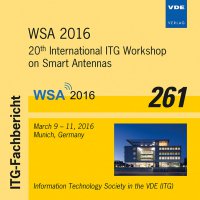Spectral Efficiency of MIMO Millimeter-Wave Links with Single-Carrier Modulation for 5G Networks
Conference: WSA 2016 - 20th International ITG Workshop on Smart Antennas
03/09/2016 - 03/11/2016 at München, Deutschland
Proceedings: WSA 2016
Pages: 8Language: englishTyp: PDF
Personal VDE Members are entitled to a 10% discount on this title
Authors:
Buzzi, Stefano; D’Andrea, Carmen (DIEI - Università di Cassino, e del Lazio Meridionale, 03043 Cassino (FR), Italy)
Foggi, Tommaso; Ugolini, Alessandro; Colavolpe, Giulio (DII - Universit`a di Parma, 43124 Parma, Italy)
Abstract:
Future wireless networks will extensively rely upon bandwidths centered on carrier frequencies larger than 10GHz. Indeed, recent research has shown that, despite the large pathloss, millimeter wave (mmWave) frequencies can be successfully exploited to transmit very large data-rates over short distances to slowly moving users. Due to hardware complexity and cost constraints, single-carrier modulation schemes, as opposed to the popular multi-carrier schemes, are being considered for use at mmWave frequencies. This paper presents preliminary studies on the achievable spectral efficiency on a wireless MIMO link operating at mmWave in a typical 5G scenario. Two different single-carrier modem schemes are considered, i.e. a traditional modulation scheme with linear equalization at the receiver, and a single-carrier modulation with cyclic prefix, frequency-domain equalization and FFT-based processing at the receiver. Our results show that the former achieves a larger spectral efficiency than the latter. Results also confirm that the spectral efficiency increases with the dimension of the antenna array, as well as that performance gets severely degraded when the link length exceeds 90-100 meters and the transmit power falls below 0dBW. Nonetheless, mmWave appear to be very suited for providing very large data-rates over short distances.


